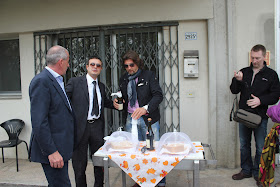We had to meet the driver in our hotel lobby at 6:50 a.m. (you can bet we were both muttering about how the tour had better be worth getting up so early). We sleepily got in the van and headed to Modena, stopping to pick up another couple on the way. After 15 minutes or so, we all warmed up a little and started chatting. We learned that the other couple was from New York and also on their honeymoon. The rest of the drive flew by and before we knew it, we were standing outside a Parmigiano-Reggiano factory. There we met two other van loads of people and our guide Alessandro.
Alessandro introduced himself and handed us all "cheese jackets" to put on before we headed inside. The reason we had to get up so early was so that we could see the cheese makers at work and learn about how Parmigiano-Reggiano is made, from start to finish.
First, the name Parmigiano-Reggiano comes from two regions where the cheese is produced: Parma and Reggio Emilia. (The cheese is also produced in Bologna and Modena -- it must come from one of these places in order to be called Parmigiano-Reggiano.) Parmigiano-Reggiano is made with three ingredients: skim milk (the milk sits overnight and is skimmed in the morning), fresh milk, and calf rennet (an enzyme from the calf's stomach, which helps coagulate the cheese). These ingredients are poured into large copper vats. The vats are cone-shaped and go down into the floor. The contents of each vat produce only two wheels of Parmigiano-Reggiano.
As the mixture is heated, it will begin to form curds.
The curds are broken apart into very small pieces with this special tool.
The mixture is then heated to 55 degrees Celsius, and the curds start to gather and clump into a single mass in the bottom of the vat.
Once the mass has formed, it must be lifted out with the aid of this paddle. The cheese makers then tie it with cheese cloth and cut the mass into two pieces, which will become the two wheels of Parmigiano-Reggiano.
Each ball of cheese is placed in one of these plastic containers along with a strip that will put the markings around it.
Eventually the cheese is moved to these airy metal holders, which allow it to dry and give it its shape. The wheels need to be turned periodically.
After that the wheels are removed form their metal casings and are put in a salt water brine for 18 days. This gives them much of their flavor.
Then they are stored so they can age. They must age for at least one year. During this time, they dry out and get a natural crust, but they also get oily, so this special machine goes up and down the rows of cheese and cleans all of the wheels periodically.
After the cheese has aged, it must be checked for quality. The head cheese maker will tap the cheese, listening for any inconsistencies and imperfections.
Then the Consortium comes in and checks the cheese and determines whether it can receive the DOP seal and be called Parmigiano-Reggiano. Each wheel will be given first grade or second grade status. If a wheel doesn't measure up, it's designated third grade and becomes just "cheese," meaning it cannot be called Parmigiano-Reggiano.
The wheels continue to age for a total of 18 to 24 months before they are ready to leave the factory.
We really learned a lot on the factory tour, and I did my best to share it all with you here, but I didn't take notes during the tour so I'm hoping I remembered everything correctly! You can find more info here.
After the tour we headed outside to sample the Parmigiano-Reggiano. We had a younger cheese and an older cheese. The older stuff is what we get in the United States and is very firm and has crystals. It was interesting to try the younger cheese, which has a creamier texture.
We also drank Lambrusco (a bubbly, food-friendly red the region is known for) and nibbled on some traditional rolls baked with veggies inside and with a lightly salted crust. By the end of the tour, I had definitely fallen in love with Lambrusco. I was already in love with Parmigiano-Reggiano.
And to show my love, we bought two 2.2-pound blocks to bring home. I worried the whole time about bringing cheese back on the plane (even though Alessandro assured us it's okay to bring Parmigiano-Reggiano back to the US), but we claimed it at customs, and no one even batted an eye.
























